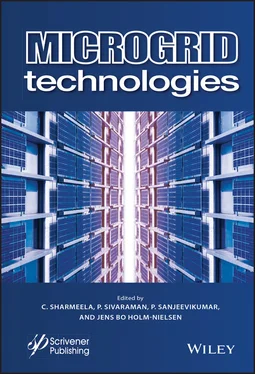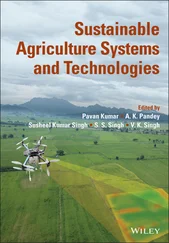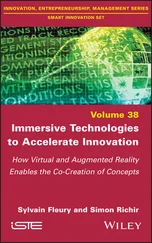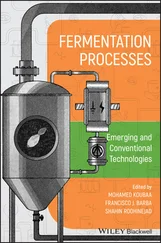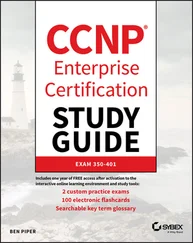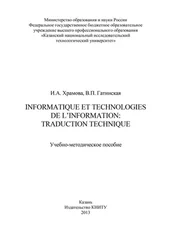1 Cover
2 Title Page
3 Copyright
4 Foreword
5 Acknowledgements
6 1 A Comprehensive Review on Energy Management in Micro-Grid System 1.1 Introduction 1.2 Generation and Storage System in MicroGrid 1.3 System of Energy Management 1.4 Algorithms Used in Optimizing Energy Management System 1.5 Conclusion References
7 2 Power and Energy Management in Microgrid 2.1 Introduction 2.2 Microgrid Structure 2.3 Power Flow Management in Microgrid 2.4 Generalized Unified Power Flow Controller (GUPFC) 2.5 Active GUPFC References
8 3 Review of Energy Storage System for Microgrid 3.1 Introduction 3.2 Detailed View of ESS 3.3 Types of ESS 3.4 Comparison of Current ESS on Large Scale 3.5 Importance of Storage in Modern Power Systems 3.6 ESS Issues and Challenges 3.7 Conclusion Acknowledgment References
9 4 Single Phase Inverter Fuzzy Logic Phase Locked Loop 4.1 Introduction 4.2 PLL Synchronization Techniques 4.3 Fuzzy Logic Control 4.4 Fuzzy Logic PLL Model 4.5 Simulation and Analysis of Results 4.6 Conclusion Acknowledgment References
10 5 Power Electronics Interfaces in Microgrid Applications 5.1 Introduction 5.2 Microgrid Classification 5.3 Role of Power Electronics in Microgrid Application 5.4 Power Converters 5.5 Conclusion References
11 6 Reconfigurable Battery Management System for Microgrid Application 6.1 Introduction 6.2 Individual Cell Properties 6.3 State of Charge 6.4 State of Health 6.5 Battery Life 6.6 Rate Discharge Effect 6.7 Recovery Effect 6.8 Conventional Methods and its Issues 6.9 Series-Parallel Connections 6.10 Evolution of Battery Management System 6.11 Modeling of Reconfigurable-BMS 6.12 Real Time Design Aspects 6.13 Opportunities and Challenges 6.14 Conclusion References
12 7 Load Flow Analysis for Micro Grid 7.1 Introduction 7.2 Load Flow Analysis for Micro Grid 7.3 Example 7.4 Energy Storage System 7.5 Connected Loads 7.6 Reactive Power Compensation 7.7 Modeling and Simulation 7.8 Conclusion References
13 8 AC Microgrid Protection Coordination 8.1 Introduction 8.2 Fault Analysis 8.3 Protection Coordination 8.4 Conclusion Acknowledgment References
14 9 A Numerical Approach for Estimating Emulated Inertia With Decentralized Frequency Control of Energy Storage Units for Hybrid Renewable Energy Microgrid System 9.1 Introduction 9.2 Proposed Methodology 9.3 Results and Discussions 9.4 Conclusion References
15 10 Power Quality Issues in Microgrid and its Solutions 10.1 Introduction 10.2 Classification of Microgrids 10.3 DC Microgrid 10.4 AC Microgrid 10.5 AC/DC Microgrid 10.6 Enhancement of Voltage Profile by the Inclusion of RES 10.7 Power Quality in Microgrid 10.8 Power Quality Disturbances 10.9 International Standards for Power Quality 10.10 Power Quality Disturbances in Microgrid 10.11 Shunt Active Power Filter (SAPF) Design 10.12 Control Techniques of SAPF 10.13 SPWM Controller 10.14 Sliding Mode Controller 10.15 Fuzzy-PI Controller 10.16 GWO-PI Controller 10.17 Metaphysical Description of Optimization Problems With GWO 10.18 Conclusion References
16 11 Power Quality Improvement in Microgrid System Using PSO-Based UPQC Controller 11.1 Introduction 11.2 Microgrid System 11.3 Unified Power Quality Conditioner 11.4 Particle Swarm Optimization 11.5 Simulation and Results 11.6 Conclusion References
17 12 Power Quality Enhancement and Grid Support Using Solar Energy Conversion System 12.1 Introduction 12.2 Renewable Energy and its Conversion Into Useful Form 12.3 Power System Harmonics and Their Cause 12.4 Power Factor (p.f.) and its Effects 12.5 Solar Energy System With Power Quality Enhancement (SEPQ) 12.6 Results and Discussions 12.7 Conclusion References
18 13 Power Quality Improvement of a 3-Phase-3-Wire Grid-Tied PV-Fuel Cell System by 3-Phase Active Filter Employing Sinusoidal Current Control Strategy 13.1 Introduction 13.2 Active Power Filter (APF) 13.3 Sinusoidal Current Control Strategy (SCCS) for APFs 13.4 Sinusoidal Current Control Strategy for ShPF 13.5 Sinusoidal Current Control Strategy for SAF 13.6 Solid Oxide Fuel Cell (SOFC) 13.7 Simulation Analysis 13.8 Conclusion References
19 14 Application of Fuzzy Logic in Power Quality Assessment of Modern Power Systems 14.1 Introduction 14.2 Power Quality Indices 14.3 Fuzzy Logic Systems 14.4 Development of Fuzzy Based Power Quality Evaluation Modules 14.5 Conclusion References
20 15 Applications of Internet of Things for Microgrid 15.1 Introduction 15.2 Internet of Things 15.3 Smart Micro Grid: An IoT Perspective 15.4 Literature Survey on the IoT for SMG 15.5 Cyber Security Challenges for SMG 15.6 Conclusion References
21 16 Application of Artificial Intelligent Techniques in Microgrid 16.1 Introduction 16.2 Main Problems Faced in Microgrid 16.3 Application of AI Techniques in Microgrid 16.4 Conclusion References
22 17 Mathematical Modeling for Green Energy Smart Meter for Microgrids 17.1 Introduction 17.2 Related Work 17.3 Proposed Technical Architecture 17.4 Proposed Mathematical Model 17.5 Results Conclusion References
23 18 Microgrid Communication 18.1 Introduction 18.2 Reasons for Microgrids 18.3 Microgrid Control 18.4 Control Including Communication 18.5 Control with No Communication 18.6 Requirements 18.7 Reliability 18.8 Microgrid Communication 18.9 Microgrid Communication Networks 18.10 Key Aspects of Communication Networks in Smart Grids 18.11 Customer Premises Network (CPN) 18.12 Architectures and Technologies Utilized in Communication Networks Within the Transmission Grid References
24 19 Placement of Energy Exchange Centers and Bidding Strategies for Smartgrid Environment 19.1 Introduction 19.2 Local Energy Centers and Optimal Placement 19.3 Local Energy Markets and Bidding Strategies Conclusion References
25 Index
26 End User License Agreement
1 Chapter 1 Figure 1.1 The renewable global status report. Figure 1.2 Consumption of renewable energy sources. Figure 1.3 Intensification of various energy sources from 1990 to 2040. Figure 1.4 Various ranges of MG. Figure 1.5 Components of micro-grid. Figure 1.6 Micro-grid in Islanded mode. Figure 1.7 Microgrid in Grid Connected mode. Figure 1.8 Energy management methodology.
2 Chapter 2 Figure 2.1 Basic structure of microgrid (MG). Figure 2.2 PAFC characteristics. Figure 2.3 PAFC average cell voltage vs current density. Figure 2.4 PAFC equivalent circuit. Figure 2.5 Basic UPFC. Figure 2.6 Basic GUPFC. Figure 2.7 GUPFC equivalent circuit. Figure 2.8 Proposed system. Figure 2.9 Proposed system with grid connection. Figure 2.10 Proposed system without grid connection. Figure 2.11 Basic control of GUPFC compensator logic. Figure 2.12 Basic control of series compensator logic. Figure 2.13 Basic control of shunt compensator logic. Figure 2.14 Simplified test system. Figure 2.15 Test system simulation. Figure 2.16 IEEE 9 bus system. Figure 2.17 IEEE 9 bus test system MATLAB simulation model. Figure 2.18 Load voltage profile in test case-1. Figure 2.19 Load voltage profile in test case-2. Figure 2.20 Load voltage profile in test case-3. Figure 2.21 Load voltage profile in test case-4. Figure 2.22 Load voltage profile in test case-5. Figure 2.23 Summary of simulation: Percentage load voltage deviation from rated ... Figure 2.24 Summary of simulation: Percentage load voltage deviation from rated ... Figure 2.25 MAC 24 network diagram. Figure 2.26 IEEE 9 bus test system.
3 Chapter 3 Figure 3.1 Load demand outline with ESS [11]. Figure 3.2 Application of ESS in a power system network [13]. Figure 3.3 (a) Aggregated system and (b) Distributed system. Figure 3.4 ESS configurations with other devices. Figure 3.5 Types of Mechanical ESS. Figure 3.6 Flywheel based ESS configuration. Figure 3.7 Structure of compressed air based ESS. Figure 3.8 configuration of PHS system. Figure 3.9 Detailed classification chemical based ESS. Figure 3.10 Functional diagram of HES. Figure 3.11 Typical view of battery-based ESS. Figure 3.12 Classifications of EES. Figure 3.13 Functional diagram of SC-based ESS. Figure 3.14 Typical view of SMES. Figure 3.15 Types of thermal-based ESS. Figure 3.16 Functional diagram of TESS. Figure 3.17 Typical Hybrid ESS.
Читать дальше
